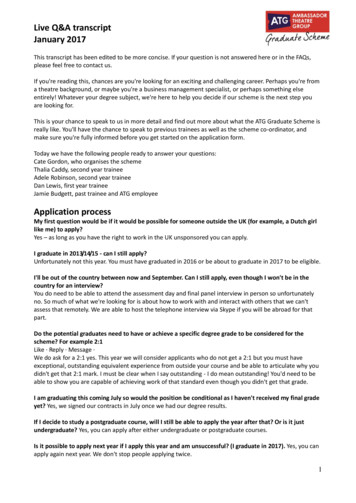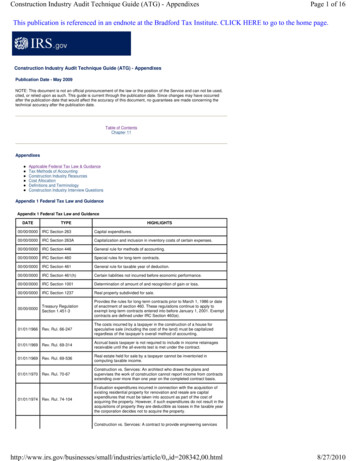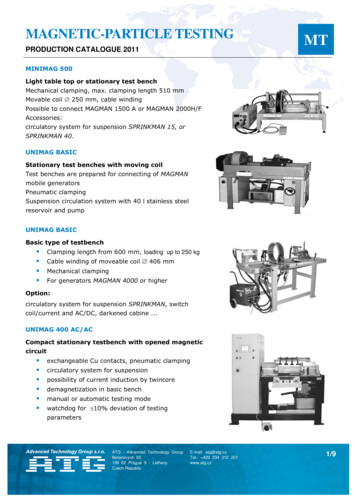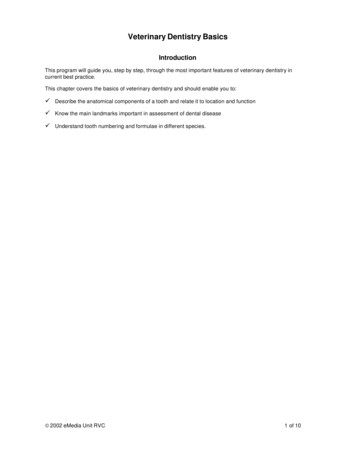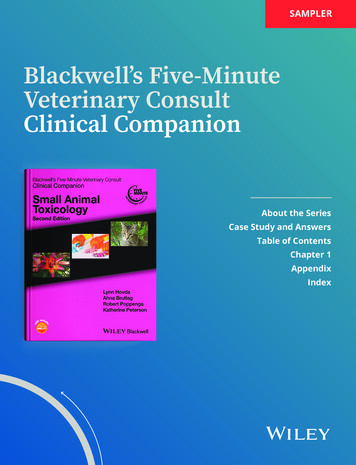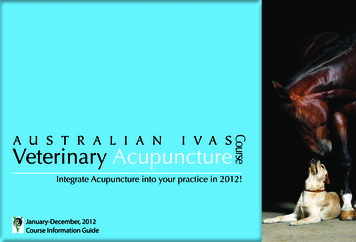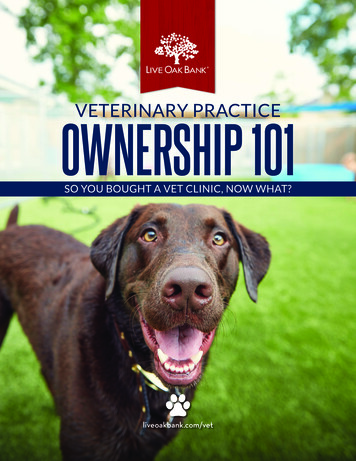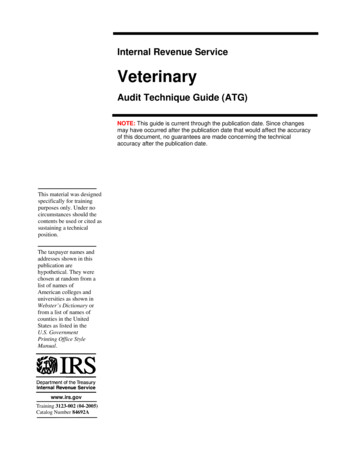
Transcription
Internal Revenue ServiceVeterinaryAudit Technique Guide (ATG)NOTE: This guide is current through the publication date. Since changesmay have occurred after the publication date that would affect the accuracyof this document, no guarantees are made concerning the technicalaccuracy after the publication date.This material was designedspecifically for trainingpurposes only. Under nocircumstances should thecontents be used or cited assustaining a technicalposition.The taxpayer names andaddresses shown in thispublication arehypothetical. They werechosen at random from alist of names ofAmerican colleges anduniversities as shown inWebster’s Dictionary orfrom a list of names ofcounties in the UnitedStates as listed in theU.S. GovernmentPrinting Office StyleManual.www.irs.govTraining 3123-002 (04-2005)Catalog Number 84692A
Veterinary Audit Technique GuideTABLE OF CONTENTSForewordChapter 1: Description of the Practice of Veterinary MedicineIndustry Background History 1-1Demographics of Veterinarians .1-1Education.1-2What Veterinarians Do .1-2Definition .1-4Veterinarians by Type of Practice .1-4Large Animal .1-4Small Animal .1-6Mixed Animal .1-6Industry Terminology . 1-6Industry Organizations .1-6Income of Veterinarians 1-7Exhibit 1-1: Glossary of Veterinary Medicine Terms 1-8Chapter 2: Industry IssuesEntity, Tax Year, and Accounting Method .2-1Entity Overview . .2-1Personal Service Corporations .2-1Personal Service Corporations & Qualified Personal ServiceCorporations Explained .2-2How to Request a Change in Tax Year under Rev. Proc. 2002-38.2-3Section 444 Election .2-3Obtaining Automatic Approval . .2-4Method of Accounting .2-4Selection of Proper Accounting Method.2-5Cash Method.2-5Accrual Method .2-6Relief from the Accrual Method .2-6Hybrid Method .2-6Is Merchandise an Element in the Taxpayer’s Businessand is it Income-Producing? .2-7Handling Changes of Accounting Method .2-9Balance Sheet Issues .2-10Intangibles .2-10
Customer Medical Records 2-10Purchase of Veterinary Practice 2-10Loans to Shareholders 2-11Potential Imputed Interest .2-11Loan or a Dividend Distribution .2-11Income Issues .2-12Gross Receipts .2-12Additional Income Issues 2-13Sale of the Veterinary Practice .2-13Passive Income Re-characterization 2-13Self-Rented Equipment .2-13Self-Charged Interest .2-14Expense Issues 2-14Lease Verses Purchase .2-14Automobile Expense 2-15Entertainment, Travel, and Meals .2-15Constructive Dividends 2-16Loans to Shareholders .2-16Payment for the Shareholder’s Benefit .2-16Excessive Compensation/Rents/Interest .2-17Shareholder’s Use of Corporate Property .2-17Bargain Purchases .2-17Section 1374 Built-In Gains IRC S1374 2-17Tax on Built-In Gains IRC S531 .2-18Whipsaw Issue .2-18Accumulated Earnings Tax Issue .2-18Conversion of a PSC to a Limited Liability Company .2-19S Corporation Issue: Inadequate Compensation .2-20Exhibit 2-1: Excerpt, AVMA .2-21Chapter 3: Examination TechniquesGeneral Techniques .3-1Veterinary Office Procedures and Records .3-1General Procedures .3-2Initial Interview/Internal Controls .3-3Initial Interview .3-3Evaluating Internal Control in a Small BusinessEnvironment 3-4Examination Techniques- Balance Sheet.3-4Cash .3-5Accounts Receivable.3-5Investments.3-5Inventory .3-5Exhibit 3-1 Form 4564, Information Document Request.3-7
Exhibit 3-2 Audit Plan 3-9Exhibit 3-3 Initial Interview Questionnaire .3-10Chapter 4: Supporting Law/ Industry Organizations and Web sitesIntroduction .4-1Exhibit 4-1 Cited Code Sections .4-2Exhibit 4-2 Cited Regulations .4-3Exhibit 4-3 Cited Revenue Rulings and Revenue Procedures .4-4Exhibit 4-4 Cited Court Cases .4-4Exhibit 4-5 Selected Industry Organizations and Web Sites .4-5Exhibit 4-6 Other Cited Web Sites .4-6
Table of Contents / Chapter 1ForewordVeterinary practices are part of the health care industry. Preparation of this ATGincluded consideration of the Los Angeles District information package entitled“Healthcare Industry.” The package was useful because medical procedures,record maintenance, terminology, and audit issues are similar.Table of Contents / Chapter 1
Table of Contents / Chapter 2Tax Code, Regulations and Official Guidance SearchChapter 1:Description of the Practice of Veterinary MedicineIndustry Background HistoryDoctors of Veterinary Medicine are medical professionals whose primaryresponsibility is protecting the health and welfare of animals and people. The firstCollege of Veterinary Medicine in the United States was established in 1879 atIowa State University. Before that time animals were treated by veterinarianstrained in Europe or by individuals without formal education. Veterinary medicinehas progressed very rapidly in the one hundred plus years since then.Veterinarians have been at the forefront in control of diseases such astuberculosis, brucellosis, hog cholera, and Newcastle disease of chickens.Today veterinarians in private clinical practice are responsible for the health ofapproximately 52 million dogs, 55 million cats, 11.7 million birds, and more than 7million other pet animals. They also care for more than 8 million horses, 115million cattle, 56 million hogs, and 12 million sheep and lambs that make up ournation’s 80 trillion livestock industry. In 2004, there were 28 colleges ofveterinary medicine in the United States graduating approximately 2,200 newveterinarians each year.Demographics of VeterinariansAs of December 31, 2003, the American Veterinary Medical Association (AVMA)officially had 70,254 members. This represents 86% of US veterinarians.The membership of the AVMA is further broken down by the following e Animal exclusively (Horse, Cattle, Sheep, Goats, Swine, etc.)Small Animal exclusively (Dogs, Cats and other pets)Mixed Practice Predominately Large Animal (80% Large/20% Small Animal)Mixed Practice Predominately Small Animal (80% Small/20% Large Animal)Bovine Practice exclusiveEquine Practice exclusiveTotal AVMA membersThese 48,172 AVMA members, or 69% of the total membership, provide directservice to animals in a practice setting. The remainder are in academia,research, state and federal government employment (including military), and1-1
public health and industry. It is estimated that the average veterinary practice inthe United States involves two veterinarians. AVMA statistics for 2001 indicatethat there are 21,044 private veterinary practices in the United States providingmedical care and professional services to animals on behalf of their owners. SeeJAVMA, Vol. 222, No.12, June 15, 2003.EducationVeterinarians require a minimum of three years pre-veterinary education followedby a four-year veterinary curriculum resulting in a Doctor of Veterinary Medicinedegree. The curriculum is extensive and includes both pre-clinical sciences andclinical sciences involving all known species of animals as well as the publichealth aspects of animal care and disease.The minimum of seven years education has escalated in cost dramatically inrecent years. In addition, many veterinarians have four or more years of collegeeducation prior to acceptance in the highly competitive programs leading to aDoctor of Veterinary Medicine degree. The average educational debt of recentgraduates (2003) is approximately 70,000. The mean educational debt for 2003graduates is over 76,000. It is not uncommon for veterinarians to owe well over 100,000. This debt often requires payment over ten to twenty years.Veterinarians are not required to complete an internship before beginningpractice. However, many internship and residency programs exist and anincreasing number of new graduates are taking advantage of them. Beforegraduate veterinarians can engage in private clinical practice, they must acquirea license issued by the state. A license is granted only to veterinarians who passstate-required examinations.What Veterinarians DoVeterinarians diagnose and control animal diseases, treat sick and injuredanimals, prevent the transmission of animal diseases to people, advise owners ofproper care of pets and livestock, and ensure a safe food supply for people bymaintaining the health of food producing animals.Veterinarians examine their animal patients, vaccinate them against diseases,treat illnesses, perform radiological and laboratory examinations, act as apharmacy, perform surgery, and advise the animal owners on ways to keep petsand livestock well nourished and healthy.Veterinarians may see their patients in a veterinary hospital or they may care fortheir patients on farms, ranches, feedlots, or other facilities. Both large and smallanimal practitioners may operate solely from self-contained mobile units, whichare designed for providing services at farms or private homes. There are a verylimited number of veterinary hospitals that are publicly supported. Veterinarians,1-2
in most cases, either own the building and equipment used to provide medicalservices for their patients, or rent it from a related or non-related entity.Veterinarians who care for the ”large” food producing animals and horses mustmaintain large inventories of animal drugs and supplies to provide these servicessince commercial pharmacies rarely have the required quantity of biologicals andpharmaceuticals for animals. Similarly, veterinarians engaged in small animalpractice must maintain the particular drugs, drug dosages and biologicals, whichare not available in commercial pharmacies. Mixed animal practitioners maintaindrugs for both large and small animals. The need to maintain drug inventoriesthat are necessary for the wide array of animals, which may not be treated withstandard human preparations, requires the veterinarian to engage in thecommercial sale of animal drugs.Many veterinary practices derive significant income from nonprofessionalservices, which include the bathing, grooming and boarding of pets. Theseactivities usually occur on the same premises where veterinary medicine andsurgery are performed. Nonprofessional staff employed by the veterinariantypically performs these services. During the holidays and summer vacationseason, a significant amount of time will be spent on the nonprofessionalactivities of boarding animals.In addition, the sale of pet and other animal feed and non-medical supplies thatanimal owners frequently request are common sources of income forveterinarians. In contrast to pet shops or feed stores, veterinarians often do notuse displays, posters, banners or other obvious forms of advertising on theirpremises despite significant sales of such products.Physicians treating humans usually derive all of their income from activities andtime devoted to providing professional services. In contrast and becauseveterinarians maintain unique facilities, they often devote a significant amount oftime to and derive significant income from nonprofessional activities such asboarding, grooming, and the sale of drugs and biologicals.Keep in mind that many veterinarians do not own practices, but are employed bypractice-owning veterinarians. Also, there are several corporations which own anational “chain” of animal hospitals and employ a large number of veterinarians.In addition, a number of veterinarians are engaged in “relief” practice where theyserve as temporary staff to other veterinarians who are required to be absent(e.g. on vacation).A significant number of veterinarians are engaged in nontraditional practice.AVMA statistics indicate almost 9,000 veterinarians are engaged in public orcorporate practice. This would include those employed by industry, universities,federal and state government and the uniformed services. These individuals1-3
usually are not small business owners, unlike those veterinarians who ownprivate practices.DefinitionThe industry includes all individuals or entities engaged in the practice ofveterinary medicine through ownership or management of practices,organizations, facilities, or equipment which provide medical services to animals.Practitioners’ activities may be reported on Form 1040 (wages or Schedule Cpractice), Form 1065, Form 1120, or Form 1120S.Owners of facilities and veterinary organizations generally will report as soleproprietors, partnerships or corporate entities. The veterinary medical practiceindustry includes, but is not limited to: Sole PractitionersVeterinary ClinicsVeterinary HospitalsDiagnostic Imaging ServicesIn-Vitro Fertilization ClinicsVeterinary OrganizationsRegulatory AgenciesEducational InstitutionsVeterinarians by Type of PracticeThe types of animals treated can also differentiate veterinary practices. Thissection discusses three major categories: Large Animal (exclusive and predominant)Small AnimalMixed AnimalLarge AnimalOne of the characteristics that distinguishes a large animal veterinary practiceor a mixed animal practice from a small animal veterinary practice is the factthat most large animal care is provided at the client’s premises rather than atthe site of the veterinary practice. However, not all large animal care isdelivered in the field. Many large animal practices have some type of in-housesurgery or facility for treating animals on the veterinarian’s premises whennecessary. These in-house facilities will vary from the very simple (forexample, a couple of stalls) to the state of the art specially constructedsurgeries, which have been designed and equipped to accommodate thephysiology of the animal being treated.1-4
Large animal veterinary care provided at the client’s premises might alter thenature of the practice and its records in several ways. It is common for theveterinarian to treat from one to several hundred animals during one visit. Toexpedite service in the field, large animal veterinarians have vehicles that areequipped to transport medications, drugs, supplies, and equipment. They mayconduct something as simple as pregnancy tests or vaccinations on severalhundred dairy cattle during one visit or as complex as treating a particulardisease outbreak on several hundred beef cattle or hogs. The nature ofanimal agriculture is such that the close quarters in which cattle aremaintained in feedlots, or dairy or hog facilities require controlling diseaseimmediately as a matter of preventing financial disaster to the farmer.When the veterinary care is delivered at the client’s premises, it is commonfor the veterinarian not to receive payment at the time the services arerendered. A “trip sheet” or “trip ticket” will probably be prepared showing theclient’s name, the date the procedure was performed, the drugs dispensed oradministered, the number of animals treated for each procedure oradministration and the mileage charged. Upon return to his/her office, theveterinarian will give the document to a staff member who will use it toprepare an invoice. The timing of sending invoices will vary from daily to onceor twice monthly. As a result, large and mixed-animal practices tend tomaintain active and ongoing accounts receivable. The particulars regardingwhether or not the veterinarian accepts payment at the time of the service,the frequency of sending invoices, and the existence of an accountsreceivable should all be specifically documented during the initial interview.As in most retail/wholesale business, veterinarians may offer different feestructures to their customers. High-volume clients may be charged less formedications and drugs than the occasional client. If this is the case, thepractice will generally utilize an indicator on its client list denoting the statusas a low, middle, or high volume client. The key for this coding should beobtained during the initial interview.Another significant feature of this type of practice is the large inventory ofmedicines that must be maintained to respond quickly to disease outbreaks orrequests for vaccination. Determine what types of inventory records aremaintained and how often a physical inventory is taken.Be aware that many large animal veterinarians often keep cattle, horses, orswine on their own farms. Determine at the initial interview how theveterinarian accounts for personal use items.Large animal practices are also subject to seasonal fluctuations in theworkload due to the differing demands of the animals treated. For instance, apractice devoted mainly to the treatment of cattle tends to be busiest duringthe spring and again during the last three months of the year. A practice1-5
specializing in the care of horses will have its busiest season during thespring. Seasonal fluctuations in business should be fully explored anddocumented during the initial interview and reconciled to the taxpayer’srecords. (See Chapter 2 for a complete discussion on selection of a taxableyear.)Small AnimalSmall animal practices vary from large animal practices in several ways. Mostof their customers come to the practice premises to be treated and paymentis expected at the time the treatment or service is rendered. However, due tothe ever-increasing cost of treatments, more and more veterinarians areallowing payment schedules. In addition, there are now several national petinsurance companies. These companies allow the customer to select anyveterinarian nationwide and then will make a payment to the veterinarian orthe insured based on a schedule of allowances less a small deductible. Forthis reason even small animal practices may maintain accounts receivable.How and when payment is expected should be discussed during the initialinterview.Since small animals are treated one at a time, not in herds, generally theneed to maintain large inventories of drugs and supplies will be diminished. Arecent trend in small animal practices has been to combine several smallanimal practices under common ownership creating a larger economic unitwith which to obtain pricing discounts on purchases of drugs and supplies.These larger organizations often maintain central purchasing and inventoryfacilities and will maintain larger inventories as a result. Therefore, it will benecessary to determine how purchases are made and how much inventory iskept on-hand.Mixed AnimalMixed animal practices will combine elements of both large and small animalpractices and will require an in-depth interview to determine which elementsof each ar
veterinary medicine through ownership or management of practices, organizations, facilities, or equipment which provide medical services to animals. Practitioners’ activities may be reported on Form 1040 (wages or S


